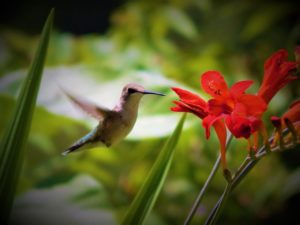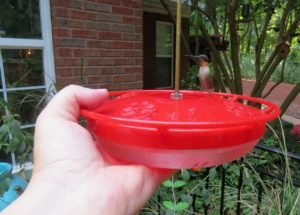 Do’s and don’ts of attracting hummingbirds and getting one to land on your hand
Do’s and don’ts of attracting hummingbirds and getting one to land on your hand
Watching a hummingbird is enchanting. Their tiny size and incredible speed make them a natural wonder. Flapping their wings an estimated 70 times per second, they can move in every direction, or simply float majestically in midair.
You may have observed hummingbirds in the wild, but you can increase your chances of seeing these delicate dynamos at home. You can even get one to land on your hand, with patience and persistence. However, before that can happen, you need to transform your backyard into a hummingbird haven.
Smart strategies for feeding hummingbirds
The National Audubon Society says to sustain their supercharged metabolisms, hummingbirds must eat once every 10 to 15 minutes and visit between 1,000 and 2,000 flowers per day. When you provide a safe, reliable food source, it’s like putting out a welcome mat for hummingbirds.
Some flowering plants are particularly attractive to hummingbirds, such as trumpet honeysuckle, bee balm and sage. A hummingbird feeder is a must-have and one of the most effective ways to consistently entice and encourage hummingbirds to visit your yard.
Keep in mind, not all feeders are created equal. The Cole’s Hummer High Rise Feeder is a smart choice. Scientifically designed with elevated perches, these feeders make hummingbirds feel safe and comfortable, which encourages them to consistently return. Hang in a tree, patio or garden spaces.
Although other hummingbird feeders tend to attract bees and ants, the Cole’s feeder is uniquely designed to keep pests at bay. It does not drip so large bees can’t get to the sweet stuff. What’s more, the Cole’s feeder has a built-in ant moat. Keep it filled with plain water and ants won’t be able to reach the nectar.
As for food, you can use traditional sugar water to feed hummingbirds, but to mimic the nectar they eat in the wild, you’ll want a liquid feed that replicates the natural sugars found in flowers. Then, you’ll be giving your favorite avian visitors a true treat.
Do’s and don’ts of attracting hummingbirds
It’s easy to make a few common mistakes when you start welcoming hummingbirds to your yard. Here’s a few tips:
* Be conscious of beneficial insects: Small insects are an important part of a hummingbird’s diet, providing essential protein to complement the nectar they drink. Try using manual or natural insect control in the afternoon when insect populations decrease.
* Do provide a water feature: Hummingbirds adore bathing. If you add a drip fountain or mister to your yard, they’ll bask in the wet wonder.
* Don’t put anything but plain water into the ant moat: Water alone will stop ants on the Hummer High Rise Feeder. Other birds may stop and take a drink from the liquid in the moat, so never use any type of repellent or additive to the water.
* Do check feeders regularly: Check at least bi-weekly to ensure a steady supply of fresh food. Clean the feeder as needed with one part white vinegar to four parts water.
* Don’t add red coloring to food: While hummers are attracted to red, adding dye to their food is unnecessary and could be harmful to their health.
* Do hang feeders in the shade: Too much sunshine and warmth can cause fermentation of sugar-based liquids. To prevent this, always hang feeders in the shade.
 How to get a hummingbird to land on your hand
How to get a hummingbird to land on your hand
Once your feeder is in regular use, it’s exciting to try to get one to land on your hand. Sit near your feeder when typically in use. Remain still as the birds must realize you’re not a threat. Repeat this several times a day for a few days, wearing the same clothing. Move a little closer each day until you’re sitting right next to the feeder.
Once the bird is comfortable having you nearby, you can try holding the feeder or cupping your hand to use as a perch underneath the feeding ports. This can take several weeks, but with consistency and patience, you’ll be able to enjoy a close-up encounter with the uniquely exquisite hummingbird. (BPT)
Published on 2018-05-16 19:14:21

